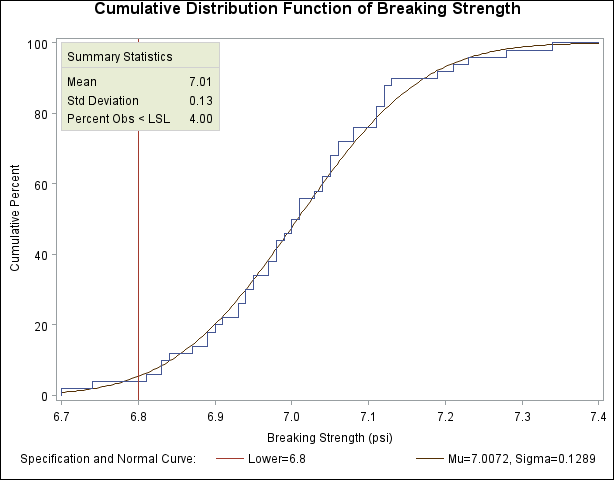CDFPLOT Statement: CAPABILITY Procedure
See CAPCDF1 in the SAS/QC Sample LibraryYou can use the CDFPLOT statement to fit any of eleven theoretical distributions (beta, exponential, gamma, Gumbel, inverse
Gaussian, lognormal, normal, generalized Pareto, power function, Rayleigh, and Weibull) and superimpose them on the cdf plot.
The following statements use the NORMAL option to display a fitted normal distribution function on a cdf plot of breaking
strengths. The data set Cord is given in Figure 5.5, and the plot is shown in Output 5.4.1.
ods graphics off;
title 'Cumulative Distribution Function of Breaking Strength';
proc capability data=Cord noprint;
spec lsl=6.8;
cdf Strength / normal;
inset mean std pctlss / cfill = ywh
format = 5.2
header = "Summary Statistics";
run;
The NORMAL option requests the fitted curve. The INSET statement requests an inset containing the mean, the standard deviation, and the percent of observations below the lower specification limit. For more information about the INSET statement, see INSET Statement: CAPABILITY Procedure. The SPEC statement requests a lower specification limit at 6.8. For more information about the SPEC statement, see SPEC Statement.
The agreement between the empirical and the normal distribution functions in Output 5.4.1 is evidence that the normal distribution is an appropriate model for the distribution of breaking strengths.
The CAPABILITY procedure provides a variety of other tools for assessing goodness of fit. Goodness-of-fit tests (see Printed Output) provide a quantitative assessment of a proposed distribution. Probability and Q-Q plots, created with the PROBPLOT (PROBPLOT Statement: CAPABILITY Procedure), QQPLOT (QQPLOT Statement: CAPABILITY Procedure), and PPPLOT (PPPLOT Statement: CAPABILITY Procedure) statements, provide effective graphical diagnostics.

